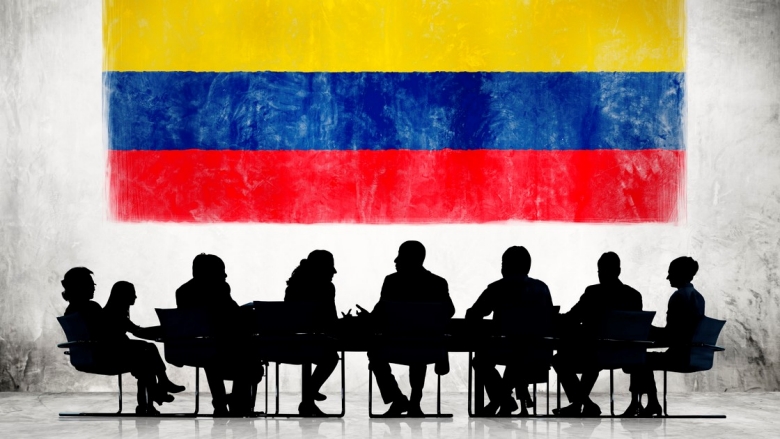Colombia has participated in numerous free trade agreements with other countries; nevertheless, the country’s economy remains relatively closed to international trade. The economy has recently become somewhat more integrated with global value chains but the lack of diversification of its exports increases exposure to external shocks.
The World Bank has been supporting the Internationalization Mission, led by Colombia’s Vice-president’s Office. This mission seeks to develop a global trade integration plan to stimulate growth and job creation. We spoke with Donato De Rosa, Program Leader for Equitable Growth, Finance and Institutions of the World Bank, regarding the importance of this mission for trade and economic recovery in a post COVID-19 world.
1. What is the Internationalization Mission and what is the Bank’s role?
The Internationalization Mission is a national government initiative implemented in coordination with the World Bank and the Institute of International and Development Studies in Geneva. The objective is to contribute to the modification and implementation of public policies associated with internationalization.
World Bank support to the Mission focuses on two areas: the provision of technical assistance by local and international experts in trade and investment and the preparation of technical notes on the different areas the mission addresses.
Dialogue with experts and the development of technical notes will focus on trade policies, promotion of foreign direct investment, global value chains, connectivity and the enabling of trade activity, analysis of exchange rates, and analysis of the institutional arrangements to promote international trade and incoming foreign investment. Seminars will be organized in some of these areas, in collaboration with the government. World Bank technical assistance will contribute to the design of the policy roadmap of the CONPES (National Economic and Social Policy Council) document on trade integration and investment.
2. What is the importance of the Mission and its results for the Colombian population?
Colombia faces major challenges in terms of competitiveness, diversification, trade integration and investment. The country’s openness to trade is limited, and its exports are heavily concentrated in commodities (fuel exports accounted for 61 percent of 2019 exports), making the economy highly vulnerable to international shocks. Additionally, Colombia has failed to take advantage of the benefits of integrating into global value chains and remains on the sidelines of foreign investment flows. These flows have stagnated over the past decade and are concentrated in the energy mining sector.
To the extent that the economy’s productivity, diversification and integration improve, Colombia will be able to take advantage of international trade opportunities, become less vulnerable to external shocks and experience increased, sustained growth. With increased participation in global markets and macroeconomic stability, Colombians will have more employment opportunities and will see their living conditions improve. Taking advantage of internationalization opportunities will also help narrow the existing gender gap in the labor market, both in terms of participation and income.
3. Recently, there was seminar on global value chains. Could you explain what they mean and why they are important? What were the main conclusions of the seminar?
Global value chains (GVC) divide the production process among different countries. Companies specialize in a specific task and engage in lasting relationships with the parties involved in production. According to the World Development Report 2020, Colombia is part of the group of countries that specialize in supplying commodities, demonstrating a low level of integration compared with countries that participate in manufacturing, service and innovation activities. Increased GVC participation could promote efficiency (through hyper-specialization), technology dissemination and access to capital and inputs (through the establishment of lasting ties among companies within the same value chain).
Deeper GVC integration and transition from a commodity-dominated trade model to one based on manufacturing would increase the country’s per capita income. Moreover, it would foster inclusive development given that countries with a higher degree of GVC integration have higher levels of labor market participation of women, as well as narrower gender pay gaps. In order to take full advantage of these opportunities, Colombia must put in place public policies to reduce global trade barriers and to manage the benefits from deeper GVC integration in an equitable manner for its population and abiding by its commitments to combat climate change and preserve the environment.
4. After the pandemic, what is the situation in Colombia in terms of global trade and what are its opportunities in the regional and global market?
The Colombian economy was hit hard by the COVID-19 shock. Its exports have suffered and the strong dependence on commodity exports has exacerbated the impact of the crisis. However, the crisis also provides an opportunity to relaunch economic growth on more solid foundations.
Going forward, the results of the Internationalization Mission can help Colombia benefit from greater interdependence with the global economy and increase the wellbeing of its population.
Colombia’s public policy framework is regarded as stable and solid, which makes the country attractive for foreign investors. Addressing the remaining bottlenecks in its policy and institutional environment, will allow Colombia to overcome the difficulties of the current crisis and achieve more sustainable and inclusive growth.

